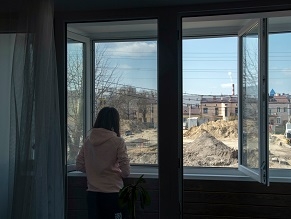|
Euroasian Jewish News

Tatyana Lakhay looking over the building site in the center of Brest, Belarus, where the remains of 1,214 people were found.CreditCreditJames Hill for The New York Times
|
Belarus Building Site Yields the Bones of 1,214 Holocaust Victims
29.04.2019, Holocaust Tatyana Lakhay, a cheerful fitness instructor in the Belarus city of Brest, returned to her apartment after a morning exercise class when she glanced out a window and came face to face with the horrors of the Holocaust.
“My God! What is going on? Something is obviously not right,” Ms. Lakhay, 26, recalled thinking as she watched a ghoulish spectacle unfold on the building site below.
Instead of the construction workers who for weeks had been preparing the foundations for a new luxury apartment project, soldiers in masks and gloves were pulling human skeletons from the earth. So many bones were coming out of the ground, she said, it was immediately clear this was no ordinary crime scene.
In the three months since that day, the ground next to Ms. Lakhay’s building has yielded the bones of 1,214 people. Most are believed to be the remains of Jews slaughtered by the Nazis after Hitler invaded the Soviet Union in June 1941. Belarus was then part of the Soviet nation.
The discovery of such a large mass grave in the center of Brest, a handsome ancient city on Belarus’s western border with Poland, has brought into focus a little-understood chapter of the Holocaust in one of the first Soviet cities seized by the Nazis.
It has also put pressure on the local authorities to halt their plans for the elite housing development and explain why they approved the project in the first place.
The World Jewish Congress condemned the project as “an affront to the memories of the Jewish residents of the city who were shot and murdered in cold blood at that very site.”
Seeking to calm the furor, Mayor Alexandr Rogachuk of Brest told local journalists last month that the city, the scene of ferocious fighting in both world wars and earlier conflicts, had been built atop the unmarked graves of countless unknown war victims.
“Everyone here is a sinner in this respect,” he said. “We are all walking on bodies,” While it was known that the building site might contain “a few dozen” bodies, the mayor said, “nobody expected such a large number.”
Jews made up about half Brest’s population of around 60,000 in 1941, and were thought to have been killed mostly in a secluded forest 70 miles east. They had been taken there by rail in an early test of logistics for Hitler’s “Final Solution.”
Evgeny Rosenblat, a historian who has studied the murder of the city’s Jews during World War II, said it had long been known that the Nazis also carried out massacres in the center of Brest. Still, he said, he was surprised by the large number of remains found on the building site. Just how and when those people died are not known, as few witnesses survived.
Most of the remains on the site, Mr. Rosenblat said, were probably of Jews who had initially managed to hide or flee but were then captured after the Nazi’s destroyed Brest’s Jewish ghetto in October 1942. He said at least two other sites in the city might also contain many bodies.
By the time the Soviet army reconquered Brest in 1944, only a handful of Jews remained. One of them was Menachem Begin, a future Israeli prime minister, who had survived because he was arrested by Stalin’s secret police before the Nazi invasion and sent to a Soviet prison camp. None of the few hundred Jews living in Brest today lived there before the war.
As well as stirring horrific historical memories, the mass grave on the building site for an luxury housing development has ignited a very contemporary debate about corruption, abuse of power and lingering anti-Semitism in a country that has been ruled for 25 years by the same iron-fisted leader, President Alexander Lukashenko.
Regina Simonenko, the leader of a local Jewish group called Brisk, the old Yiddish name of Brest, complained that municipal authorities should never have issued a building permit for the site and are now rushing to bury the uncovered bones without a proper investigation of whose remains they are and what other bodies might lie nearby.
Local officials, Ms. Simonenko said, were focused on celebrating the 1,000th anniversary of Brest’s founding and wanted to keep the discovery of the mass grave quiet. They acknowledged it, she said, only after Ms. Lakhay and others began posting videos on social media of the site piled with bones.
Alla Konduk, a local official, denied any desire to hide what had been found, saying that a special forensic military unit had been called in on Jan. 17, immediately after construction workers told city authorities about the remains.
Ms. Konduk said that the foundations of the planned project would not touch the mass grave and that construction, halted since January, would soon resume.
This has infuriated Irina Lavrovskaya, an architect and a preservation campaigner. She started an online petition demanding that construction on the site be halted completely and that it be fenced off and turned into a “memorial park” for Jews murdered by the Nazis.
By Andrew Higgins
The New York Times
|
|
